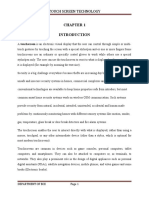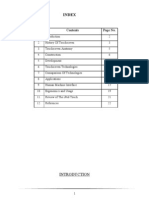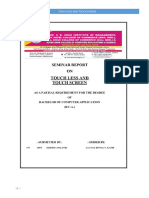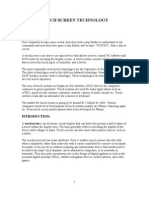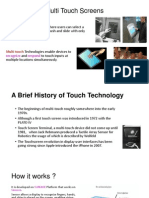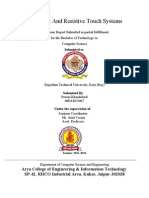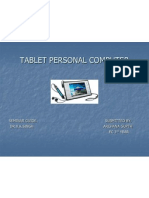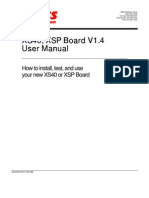History
History
Uploaded by
Muhammad Zain YousafCopyright:
Available Formats
History
History
Uploaded by
Muhammad Zain YousafOriginal Title
Copyright
Available Formats
Share this document
Did you find this document useful?
Is this content inappropriate?
Copyright:
Available Formats
History
History
Uploaded by
Muhammad Zain YousafCopyright:
Available Formats
Muhammad Zeeshan Page 3 11:55 a10/p10 10/5/2010
History
Touch screens emerged from academic and corporate research labs in the
second half of the 1960s. One of the first places where they gained some
visibility was in the terminal of a computer-assisted learning terminal that
came out in 1972 as part of the PLATO project. They have subsequently
become familiar in kiosk systems, such as in retail and tourist settings, on
point of sale systems, on ATMs and on PDAs where a stylus is sometimes
used to manipulate the GUI and to enter data. The popularity of smart
phones, PDAs, portable game consoles and many types of information
appliances is driving the demand for, and the acceptance of, touch screens.
The HP-150 from 1983 was probably the world's earliest commercial touch
screen computer. It doesn't actually have a touch screen in the strict sense,
but a 9" Sony CRT surrounded by infrared transmitters and receivers which
detect the position of any non-transparent object on the screen.
Until the early 1980s, most consumer touch screens could only sense one
point of contact at a time, and few have had the capability to sense how hard
one is touching. This is starting to change with the commercialization of
multi-touch technology.
Touch screens are popular in heavy industry and in other situations, such as
museum displays or room automation, where keyboard and mouse systems
do not allow a satisfactory, intuitive, rapid, or accurate interaction by the
user with the display's content.
Historically, the touch screen sensor and its accompanying controller-based
firmware have been made available by a wide array of after-market system
integrators and not by display, chip or motherboard manufacturers. With
time, however, display manufacturers and chip manufacturers worldwide
have acknowledged the trend toward acceptance of touch screens as a highly
desirable user interface component and have begun to integrate touch screen
functionality into the fundamental design of their products.
You might also like
- Inputing Data in Other WaysDocument9 pagesInputing Data in Other WaysFai ShNo ratings yet
- Touch Screen Technology 1BI17MCA07: Dept. of MCA, BIT 2019 Page - 1Document17 pagesTouch Screen Technology 1BI17MCA07: Dept. of MCA, BIT 2019 Page - 1Auchitya SinghNo ratings yet
- Touch Screen TechnologyDocument19 pagesTouch Screen TechnologyPrabhavathiNo ratings yet
- Index: S.no. Page NoDocument22 pagesIndex: S.no. Page NoArjun AryaNo ratings yet
- Irjet V7i3870Document6 pagesIrjet V7i3870Sivasai KannikantiNo ratings yet
- Irjet V7i3870Document10 pagesIrjet V7i3870Abhishek SukhasareNo ratings yet
- Theroy of SeminarDocument48 pagesTheroy of Seminarvijiya singh rajawatNo ratings yet
- Touch ScreenDocument7 pagesTouch ScreenRajeev KumarNo ratings yet
- 179 Krishna SolankiDocument20 pages179 Krishna Solankiarpitvaghasiya1No ratings yet
- Touch ScreenDocument3 pagesTouch Screensantu12321No ratings yet
- Touchless Touchscreen Seminar by Kayode Damilola SamsonDocument25 pagesTouchless Touchscreen Seminar by Kayode Damilola SamsonBobby ZackNo ratings yet
- Touch Screen MonitorDocument12 pagesTouch Screen MonitoratteenNo ratings yet
- Touch Screen TechnologyDocument15 pagesTouch Screen TechnologyKatib Shazaib AhmedNo ratings yet
- Index: Pageno NumberDocument17 pagesIndex: Pageno NumbervidyaNo ratings yet
- Touchless Touchscreen SEMINAR REPORTDocument31 pagesTouchless Touchscreen SEMINAR REPORTVaahila ReddyNo ratings yet
- Recent Trends in TechnologyDocument10 pagesRecent Trends in TechnologySmruti BeleNo ratings yet
- Slide 3Document7 pagesSlide 3Mehataz KhanNo ratings yet
- Touchless Touchscreen Seminar ReportDocument31 pagesTouchless Touchscreen Seminar ReportPriyanshu MangalNo ratings yet
- Surface ComputingDocument2 pagesSurface ComputingGetzi Shinola ImmanuelNo ratings yet
- Multi Touch Screen Technology: Seminar ofDocument25 pagesMulti Touch Screen Technology: Seminar ofgopyaleNo ratings yet
- Surface Computing Final ReportDocument34 pagesSurface Computing Final ReportSaurav SaurateNo ratings yet
- Abstract 2 Auto Saved)Document32 pagesAbstract 2 Auto Saved)kajaradhikaNo ratings yet
- Touchscreen Is An Electronic Visual Display That Can Detect The Presence and Location of A Touch Within The Display AreaDocument9 pagesTouchscreen Is An Electronic Visual Display That Can Detect The Presence and Location of A Touch Within The Display AreaPaul HezekiahNo ratings yet
- Touch Screen: DefinitionDocument22 pagesTouch Screen: Definitionakash7887No ratings yet
- Touchscreen Seminar ReportDocument9 pagesTouchscreen Seminar ReportEswar SanthatiNo ratings yet
- Computers Would Be Useless Without Input DevicesDocument2 pagesComputers Would Be Useless Without Input DevicesDanica ConcepcionNo ratings yet
- Elements of Multimedia SystemDocument9 pagesElements of Multimedia SystemM'ir Usai'lNo ratings yet
- Touch Screen Technology: Click To Edit Master Subtitle Style Coordinator: Mr. Thyagarajmurthy B.EDocument20 pagesTouch Screen Technology: Click To Edit Master Subtitle Style Coordinator: Mr. Thyagarajmurthy B.Eswathipm97No ratings yet
- Touch Screen: Sagar Singha 08182003051 ECE SEMDocument13 pagesTouch Screen: Sagar Singha 08182003051 ECE SEMSubir MaityNo ratings yet
- Touch Screen Technology DocumentationDocument21 pagesTouch Screen Technology DocumentationUday Pratap64% (11)
- Wearable ComputerDocument6 pagesWearable ComputerSwathi SadanandanNo ratings yet
- Seminar': Touch ScreensDocument9 pagesSeminar': Touch ScreensAravindSureshNo ratings yet
- Multi Touch ScreensDocument16 pagesMulti Touch ScreensDevon CurtisNo ratings yet
- 2####Document9 pages2####RAFI ULLAH RAFINo ratings yet
- Touchscreen - PowerPointDocument29 pagesTouchscreen - PowerPointBassem El AhmarNo ratings yet
- Makalah Bahasa InggrisDocument13 pagesMakalah Bahasa InggrisHari TarunaNo ratings yet
- Touchscreen: From Wikipedia, The Free EncyclopediaDocument16 pagesTouchscreen: From Wikipedia, The Free EncyclopediaRishi KalaNo ratings yet
- 50af86017bbd71 70174069Document10 pages50af86017bbd71 70174069saleemnasir2k7154No ratings yet
- The History of Smartphones and Who Invented ThemDocument15 pagesThe History of Smartphones and Who Invented ThemjrmutengeraNo ratings yet
- Information and Communicatins TechnologyDocument19 pagesInformation and Communicatins Technologytembozoey058No ratings yet
- Touchless Touch Screen: Submitted in Partial Fulfillment of Requirement For The Award of The Degree ofDocument68 pagesTouchless Touch Screen: Submitted in Partial Fulfillment of Requirement For The Award of The Degree ofpavan kumarNo ratings yet
- InfoDocument10 pagesInfoILFA SALEEMNo ratings yet
- Seminar3 SynopsisDocument13 pagesSeminar3 SynopsisSwapnil PatilNo ratings yet
- Wearable Computers Seminar ReportDocument7 pagesWearable Computers Seminar ReportAman SaxenaNo ratings yet
- Simputer Technology SemDocument9 pagesSimputer Technology SemRohit ShindeNo ratings yet
- Human Computer Interface (Hci)Document2 pagesHuman Computer Interface (Hci)egwujoshua880No ratings yet
- Ict Report 1.1Document53 pagesIct Report 1.1jomagdalenelabradorromeroNo ratings yet
- Seminar Report Capacitive Resistive Touch SystemsDocument8 pagesSeminar Report Capacitive Resistive Touch SystemsRahul Chhiber100% (1)
- PixelSensecollege ReportDocument30 pagesPixelSensecollege ReportPankaj KumarNo ratings yet
- Arch An ADocument16 pagesArch An Adivya_cestNo ratings yet
- Touch Screen: Rao&Naidu Engineering College Department of Eee Presented BYDocument16 pagesTouch Screen: Rao&Naidu Engineering College Department of Eee Presented BYVenky VenkiNo ratings yet
- Hand Held SystemDocument20 pagesHand Held SystemJared AllenNo ratings yet
- IT Application and Tools in BusinessDocument2 pagesIT Application and Tools in BusinessJohn Boski JavellanaNo ratings yet
- Wearable Technology Research PaperDocument7 pagesWearable Technology Research PaperNIMISHNo ratings yet
- Unit 2Document2 pagesUnit 2api-285399009No ratings yet
- English Papers Touch Screen: By: Iwan Fajri M. Rifki Emeraldi Nanda Wiranata Niken Ira Widodo Class:3CBDocument15 pagesEnglish Papers Touch Screen: By: Iwan Fajri M. Rifki Emeraldi Nanda Wiranata Niken Ira Widodo Class:3CBVinichen Nichen Peridot AinieNo ratings yet
- Introduc Tion: A Touch Screen Is Computer Display Screen That Is Sensitive To Human Touch, Allowing A UserDocument152 pagesIntroduc Tion: A Touch Screen Is Computer Display Screen That Is Sensitive To Human Touch, Allowing A UserSurina PundirNo ratings yet
- MIS Tablet Vs Laptop ProjectDocument18 pagesMIS Tablet Vs Laptop ProjectchetanjaNo ratings yet
- Microsoft PixelSense: Revolutionizing Human-Computer Interaction Through Visual SensingFrom EverandMicrosoft PixelSense: Revolutionizing Human-Computer Interaction Through Visual SensingNo ratings yet
- Large Scale Battery Storage SystemsDocument1 pageLarge Scale Battery Storage SystemsMuhammad Zain YousafNo ratings yet
- ReferencesDocument2 pagesReferencesMuhammad Zain YousafNo ratings yet
- 1 - OverviewDocument17 pages1 - OverviewMuhammad Zain YousafNo ratings yet
- Rollno - Name - SectionDocument2 pagesRollno - Name - SectionMuhammad Zain YousafNo ratings yet
- Ali AsignmentDocument10 pagesAli AsignmentMuhammad Zain YousafNo ratings yet
- Xs40 Manual v1 4Document19 pagesXs40 Manual v1 4Muhammad Zain YousafNo ratings yet


